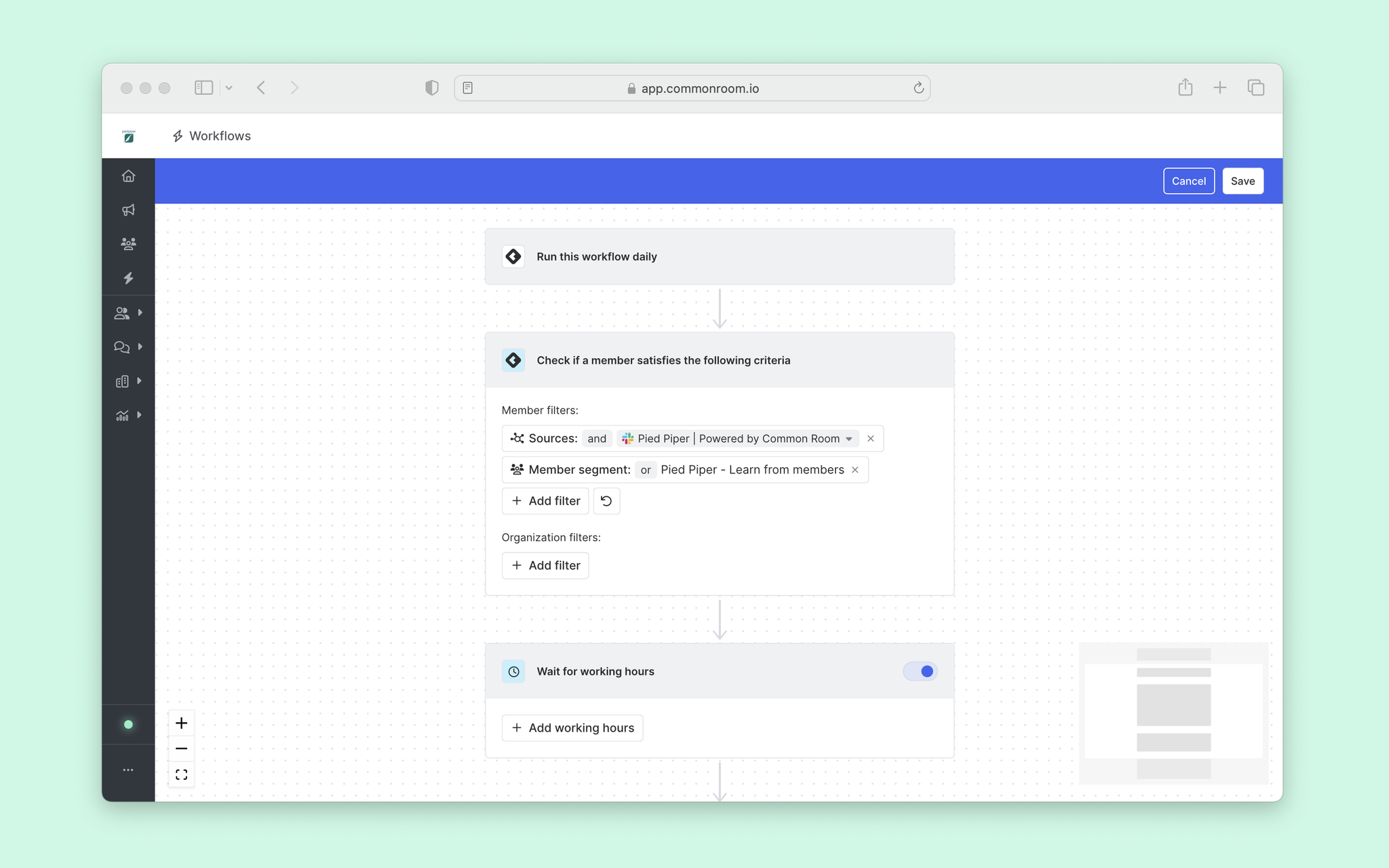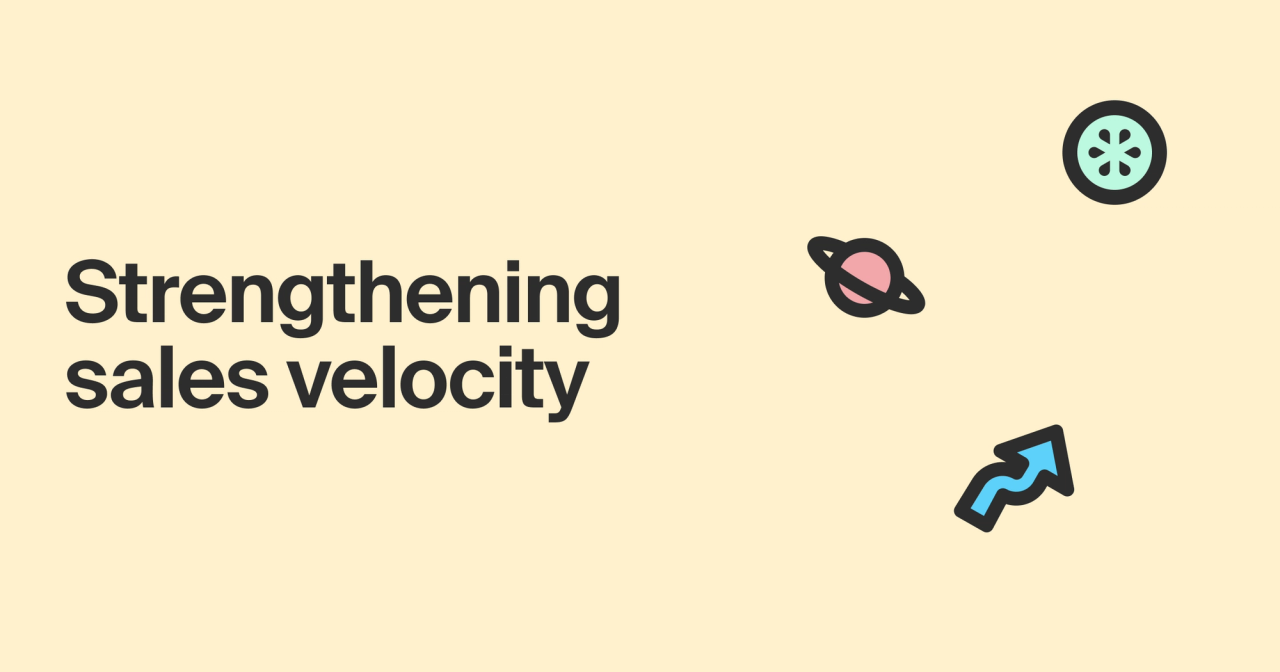If you’re on the hunt for sales velocity strategies, it means you know something others don’t: Your sales pipeline is only as good as the speed at which deals move through it.
It probably also means you’re fed up with second-rate strategies that fail to move the needle.
Improving your sales velocity—how quickly prospective customers move through the sales funnel and become paying customers—helps you forecast revenue more accurately, find ways to hit your commercial goals faster, and cut down on end-of-quarter heartburn.
Keep reading to learn:
- Why sales velocity is so crucial
- What influences sales velocity
- How to get your sales velocity in tip-top shape
Sales velocity by the numbers
No matter what you call it—sales velocity, sales funnel velocity, pipeline velocity—it all boils down to the same thing: how quickly someone goes from lead to closed-won. This tells you how quickly your company generates revenue and roughly how much.
Calculating your sales velocity is fairly straightforward. You multiply the number of opportunities you have by your average deal size, then multiply that number by your win rate. Take the result and divide it by the length of your sales cycle.
Like this:
This reveals a lot more than your revenue forecast for the weeks ahead. It also tells you how healthy your sales pipeline is, whether your marketing is on point, and how you’re doing in terms of sales effectiveness and efficiency.
In short, it’s a great way to evaluate your current GTM strategy and spot areas for improvement.
But no matter how you measure up, the goal is always to do better. And to do that, you have to pull the right levers:
- Increase the number of qualified opportunities in your sales pipeline.
- Increase the average dollar amount a deal generates (this’ll give your customer lifetime value a nice boost, too).
- Increase the percentage of opportunities that become closed-won deals.
- Decrease the number of days it takes for a deal to reach closed-won.
Here are three sales velocity strategies that will help you do just that (and three that won’t).
3 sales velocity strategies to add to your toolkit
These strategies will help you build more pipeline, separate the best deals from the rest, and close more deals faster:
1. Shed light on your dark funnel
If you’re still relying on traditional touchpoints in the sales funnel to find leads, you’re doing it wrong.
The vast majority of the customer journey (like 95%) is happening across channels you can’t see or track (aka the dark funnel). To find more opportunities, you need visibility into buyer activities across the digital landscape.
Just ask the team at Temporal, which uses Common Room to centralize its view of activity across Slack, LinkedIn, Twitter, Discourse, YouTube, and other channels. More than 50% of its meetings now come from Common Room.
🎤 “That's the first place I check every single day and it's much easier to reach out to prospects very quickly. Using Common Room, I know immediately when someone posts a comment on LinkedIn or a question on a community forum.”
—Gozie Nwachukwu, Head of Sales Development at Temporal
2. Prioritize the right prospects
Not all prospects are created equal. Fueling pipeline growth and velocity means focusing on fit, not just intent.
Even if you could track all relevant digital activity at the user level on your own (godspeed), it’s nearly impossible to match purchase intent with product and customer fit. To better allocate your resources, you need insight into which opportunities are worth your time (and have the highest chance of success).
That’s what the team at Prisma does, using Common Room to filter opportunities based on organization-specific criteria.
🎤 “My day to day was going into Prisma's Common Room platform and seeing which organizations were engaging with us. And it's really cool because I can filter out each organization by their size.”
—Anita Cung, Sales Development Representative at Common Room (formerly Prisma)
3. Strike while the iron is hot
It’s not enough to know who to reach out to. If you want to work smarter, not harder, you also need to know when and where.
GTM teams have to sift through a firehose of leads, narrow down their lists, and keep up with prospects in real time. To act on opportunities quickly and at scale, you need automated workflows that help you stay up to date on relevant activity, build a reliable source of customer truth, and instantly take action on it.
Case in point: Census. It uses Common Room to notify GTM teams about high-priority accounts via automated alerts and keep tabs on individuals of interest via reactive segments. This makes following up with leads a breeze (and helps speed up deal time to close by 40%).
🎤 “The insights brought together by Common Room ensure our team can engage with the right person at the appropriate time with an offer that truly aligns to their needs.”
—Allie Beazell, Marketing Chief of Staff and Director of Developer Marketing at Census
3 sales velocity strategies to show the door
These strategies will lead you on wild goose chases, fill your pipeline with vanity metrics, and slow down the sales process:
1. Put quantity over quality
You can slap a “marketing-qualified lead” sticker on every form fill, but that doesn’t mean those leads will convert.
Filling up your pipeline with weak leads means wasting time on the wrong people while the right ones (who have bigger billfolds, naturally) pass you by.
2. Use standard intent data
Most buyer intent tools give you weak (and often outdated) signals.
You may learn that someone at a target account is engaging in an activity you want to know about, but you have no idea who that person is or whether they’re actually interested in doing business. This makes for sloppy prioritization and slipshod outreach.
3. Send out spray-and-pray messaging
Blasting out one-size-fits-all emails and LinkedIn DMs will get you into a lot of inboxes. But it won’t book a lot of meetings (especially if the recipients prefer other digital watering holes).
Knowing that a prospect fits your ideal customer profile is only step one. You need to speak to their pain points and commercial goals—and do it on the channels where they spend their time. Without context and visibility, you’re just throwing things at the wall to see what sticks.
How Common Room helps you pick up the pace
Common Room acts as the command center for all your digital interaction, product usage, and customer relationship data.
Dozens of natively built and fully managed integrations help you get visibility into traceable digital activity, combine it with the product and customer data you already have, and connect it to your preferred marketing and sales technologies.
AI-powered enrichment resolves customer identities and creates profiles for prospects and the organizations they work at. This helps you find opportunities you didn’t even know existed long before they’re spotted in your CRM.

Common Room’s filters let you drill down into leads and create cohorts of high-intent, high-fit prospects based on key criteria, such as job title, location, industry, company size, and annual revenue. Those leads can automatically be added to fully customizable segments based on preset criteria so you track activity throughout the buying cycle, as well as report on or engage groups of prospects at scale.
Demographic and firmographic information—mixed with real-time conversational and behavioral data—tells you what prospects are saying and doing, why, and how they feel about it. This helps you zero in on the biggest and best opportunities and personalize your approach accordingly.

Automated workflows in Common Room make it easy to engage prospects on their channels of choice. Meanwhile, team alerts instantly notify you of any prospect activity you want to know about.
This helps you push deals over the finish line and speed up time to close by taking the right action in the right place at the right time.

Sales velocity isn’t just about moving faster—it’s also about moving more intelligently.
Common Room helps GTM teams create more high-quality pipeline and close it faster by upwards of 20%.
Upgrade your sales velocity strategy with Common Room
Ready to see how Common Room helps you convert more customers faster?

